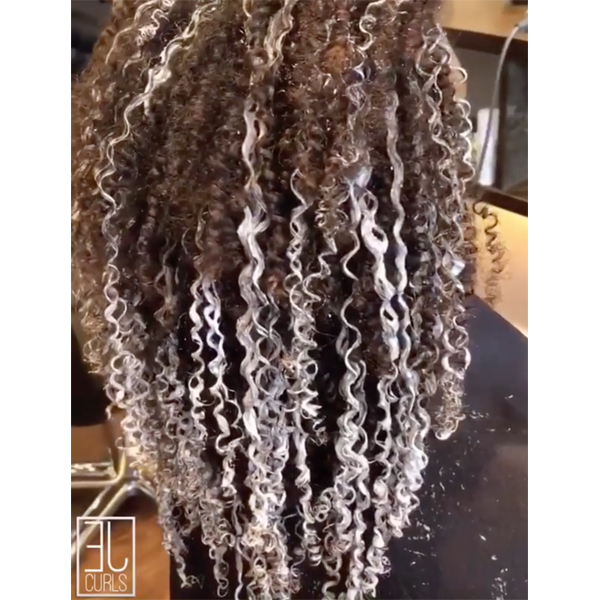4 Dos & Don’ts For Coloring Curly Hair
Learn How To Color Curly Hair Like A Pro
Let’s talk about curly hair, specifically coloring curly hair. Whether she wants subtle pops of brightness or a fun fashion color, there are some things you need to be wary of, like what over-processing will do to her curl pattern and why the porosity of her hair matters when formulating. So we talked to curl specialist and BTC Team Member Evan Joseph (@evanjosephcurls) to find out his dos and don’ts for coloring curly hair. Read on to see what he said!
Products Used
Don’t: Over-Process The Hair
If you lift her strands higher than the base color is capable of, you’re going to relax the hair and disrupt the curl pattern.
Do: Skip The Foils
Opt for open air process and only lift her hair to a place where her curls will still be healthy. “Curly hair has a tendency to be really fine, and when you put curly hair inside a foil packet it just lifts too quickly,” shares Evan. If it feels like you need some warmth to help her hair lift a little higher, place plastic wrap between your sections.
Note: When working with virgin hair, Evan recommends lightening with Schwarzkopf Professional IGORA ROYAL® Fashion Lights® because it’ll maintain the curl pattern better.

Don’t: Just Formulate To The Desired Shade
Unless she has perfectly healthy hair—or better yet, virgin hair—formulating to match the shade she wants doesn’t guarantee it’ll work out. Depending on the condition of her curls, you could end up with a shade that is a few shades darker.
Do: Consider The Porosity Of The Hair
Think of it this way: If you put a Level 6 on extremely porous hair, it could look like a Level 4 which means it would look much darker than planned. “When you’re going darker, it’s better to go lighter with your shades,” advises Evan. “Sometimes a shade to a shade and a half lighter will be exactly where your client wants it rather than going right for the desired shade.“
Don’t: Go Fashion Color Crazy
That doesn’t mean your curly-haired clients can’t rock vibrant colors, but because her hair has so much movement already you should stick to colors that are softer.
Do: Think About Her Hair As A Whole
Just like with cutting, when you’re coloring curly hair you want to create a beautiful, cohesive look that isn’t too harsh on the eyes. So rather than create a multi-tonal masterpiece, stick to natural-looking techniques like ombré, balayage and highlights or paint one color from roots to ends.
Click through the slideshow below to see some of the color transformations Evan shared to his Insta!
Don’t: Color Damaged Hair
We know this sounds a little obvious but some stylists will still color damaged hair to avoid telling a client no. We get it, angry clients aren’t fun to deal with but Evan says in the end, they won’t be happy if their hair doesn’t curl. So proceeding with the appointment will only keep your client on this never-ending cycle of damaged hair.
Do: Communicate With Your Client
Clearly explain why it won’t be possible to color her hair just yet and assure her that you’ll help reverse the damage with a good product regimen and routine cuts.
More from
Evan Joseph
-
Balayage
3 Genius Tips For Coloring Curly Hair
-
#thebtcshow 2019
#THEBTCSHOW 2019: DAY 3
-
#thebtcshow 2019
Texture Co-Lab at #THEBTCSHOW 2019
-
#thebtcshow 2019
#THEBTCSHOW 2019: Day 1
-
#thebtcshow 2019
Schwarzkopf Professional at #THEBTCSHOW 2019
-
Business
How To Set Boundaries With Clients
-
Bobs
Why You Should Try Using Head Sheets For Haircuts
-
BTC Events
BTC “ON TOUR” DALLAS
-
BTC ON TOUR
“On Tour” Dallas Cocktail Party
-
BTC Events
BTC “On Tour” Dallas Show—Here’s Everything That Happened!
-
BTC Events
BTC’s Next “On Tour” Show Is In Dallas—Here’s The OMG Artist Lineup!
-
Curls
This Add-On Scalp Service Is Like A Facial For The Hair
-
BTC Events
BTC “ON TOUR” CHICAGO
-
Curly
3 Tips For Cutting Bangs On Curly Hair
-
BTC Events
BTC “ON TOUR” New York City—Here’s What Went Down!
-
BTC Events
BTC “ON TOUR” New York City
-
BTC Events
BTC’s “On Tour” Show Is Coming To Chicago—Here’s The Artist Lineup!
-
Events
3 Curly Hair Lessons From BTC’s First In-Person Class
-
Curly
Curly Cutting 101 With A Curl Expert
-
Curls
4 Styling Mistakes That Will Disrupt Her Curl Pattern
-
Curly
How Precision Cutting Works & Why It’s Ideal For Curly Hair
-
BTC Events
BTC Launches “On Tour” Show In New York City—Here’s The Artist Lineup!
-
Curly
3 Reasons Why You Should Cut One Curl At A Time
-
Curly
Cutting Curly Hair: 3 Common Mistakes & How To Avoid Making Them












